Abstract
Six multiple variable-interval schedules each comprised one variable-interval sixty second component and an alternated component which was varied. Four pigeons' responses were recorded in five successive subintervals of each component. Response rate changes across subintervals revealed instances of local contrast and small local induction effects in the changed component. In the constant component, smaller local contrast and larger local induction effects obtained. Accordingly, the magnitude of behavioral contrast, defined as an inverse relation between response rate in the constant component and reinforcement rate in the changed component, did not change reliably across subintervals of the constant component. Ratios of response rates in initial subintervals were highly sensitive to reinforcement ratios. Sensitivity decreased sharply over the first two-fifths of the components and remained constant for the remainder. The results demonstrated that changes in multiple schedule sensitivity are a function of time since the alternation of successive components.
Keywords: undermatching, behavioral contrast, local contrast, component subintervals, multiple variable-interval schedules, key peck, pigeons
Full text
PDF
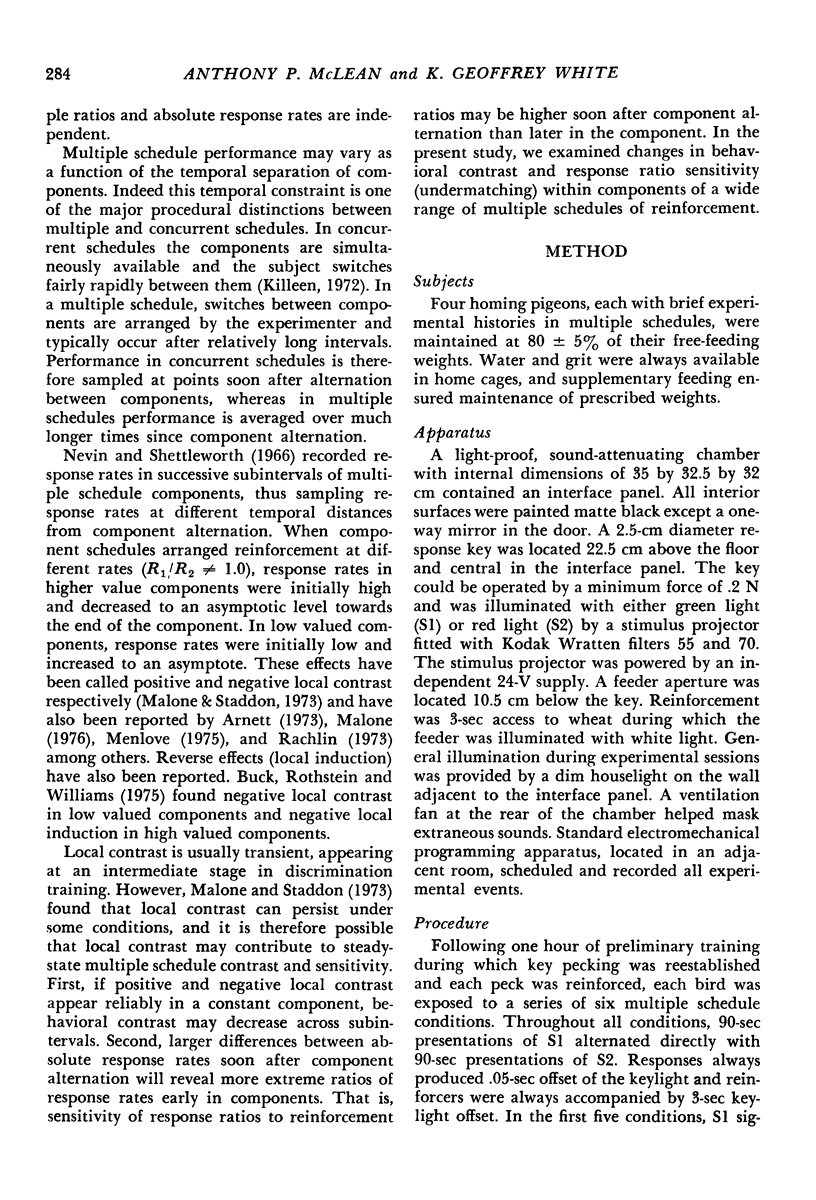

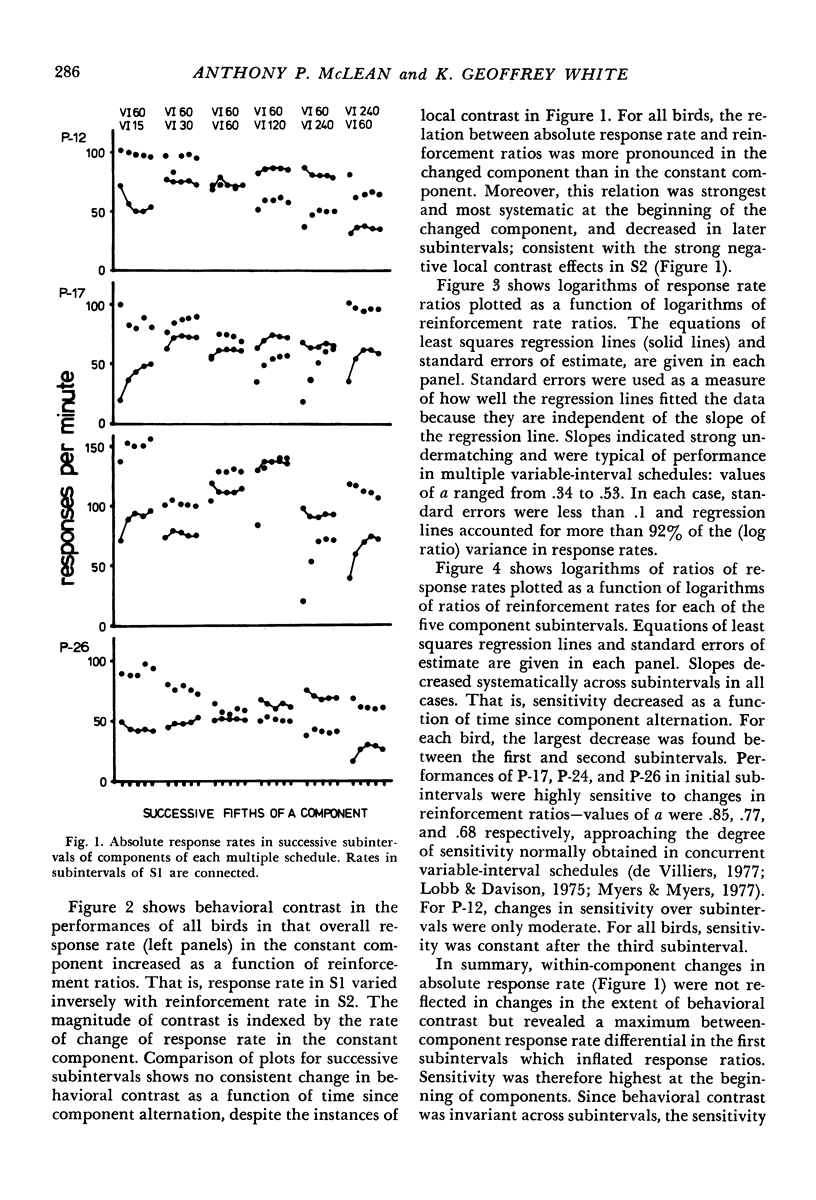
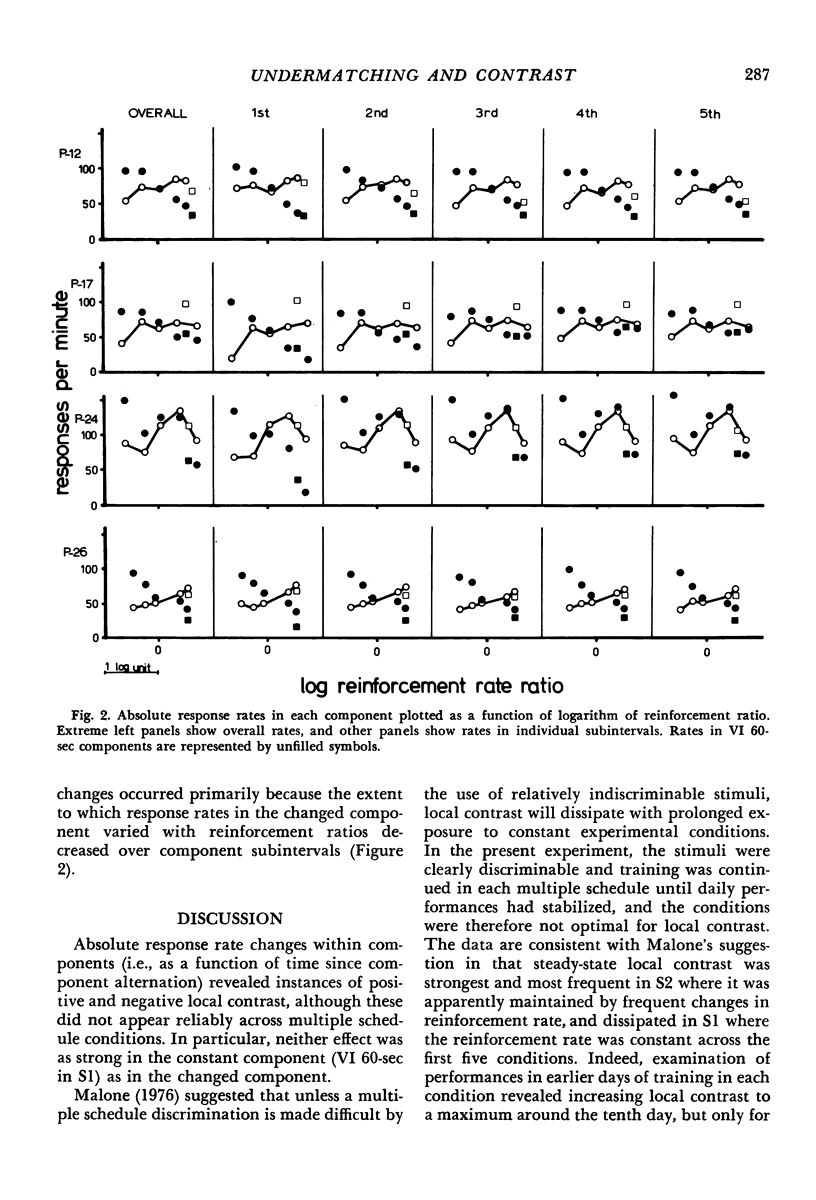
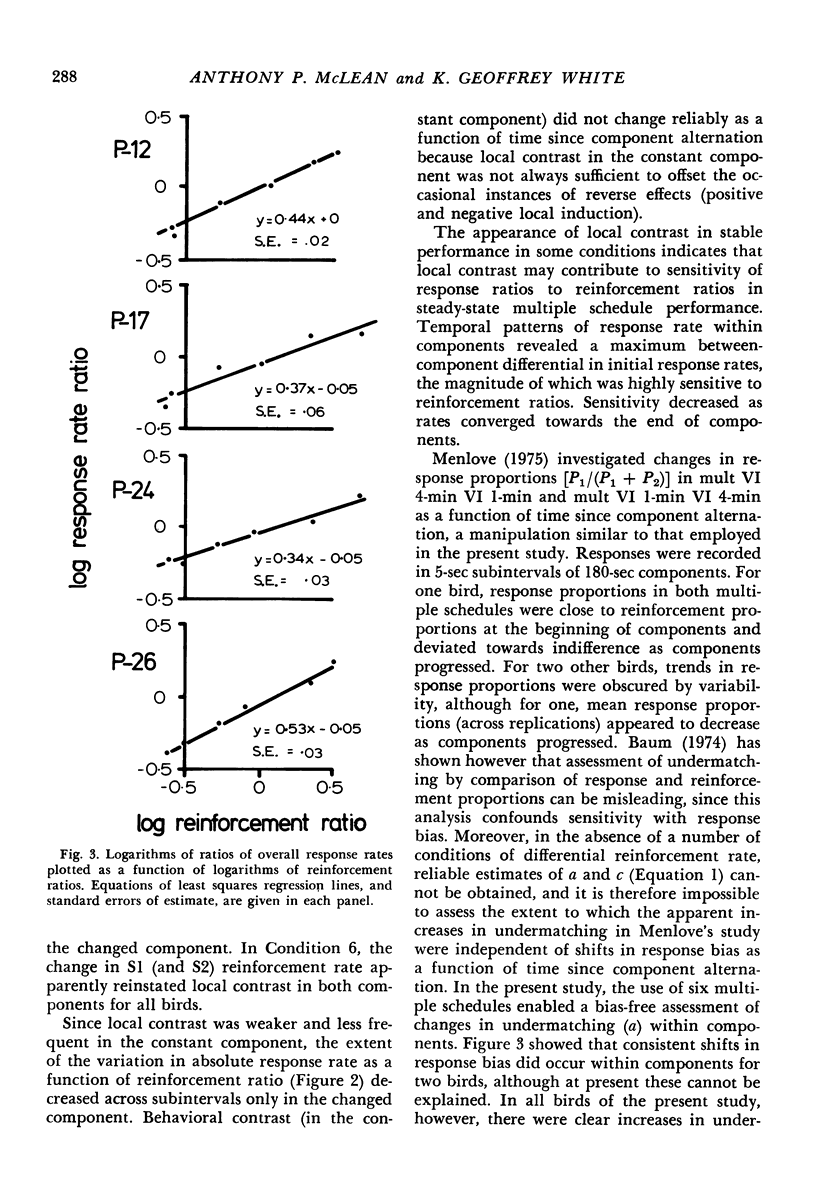

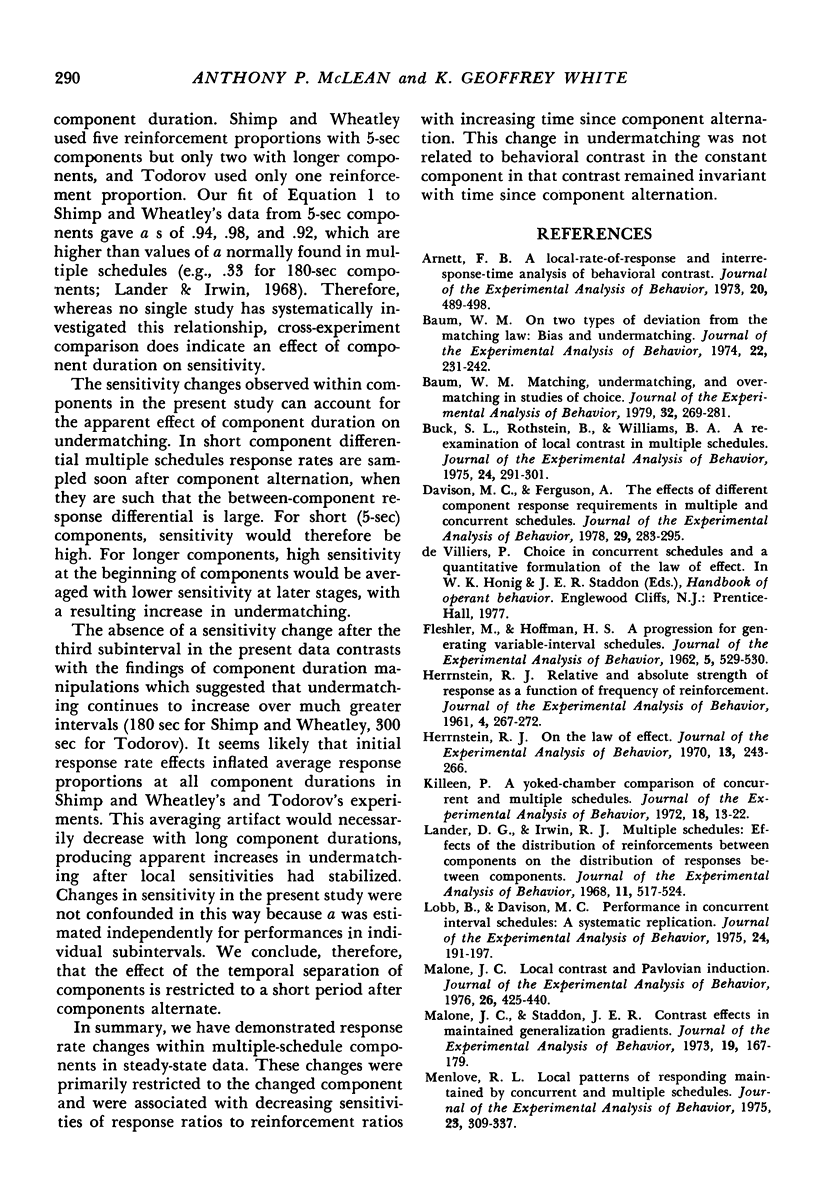

Selected References
These references are in PubMed. This may not be the complete list of references from this article.
- Arnett F. B. A local-rate-of-response and interresponse-time analysis of behavioral contrast. J Exp Anal Behav. 1973 Nov;20(3):489–498. doi: 10.1901/jeab.1973.20-489. [DOI] [PMC free article] [PubMed] [Google Scholar]
- Baum W. M. Matching, undermatching, and overmatching in studies of choice. J Exp Anal Behav. 1979 Sep;32(2):269–281. doi: 10.1901/jeab.1979.32-269. [DOI] [PMC free article] [PubMed] [Google Scholar]
- Baum W. M. On two types of deviation from the matching law: bias and undermatching. J Exp Anal Behav. 1974 Jul;22(1):231–242. doi: 10.1901/jeab.1974.22-231. [DOI] [PMC free article] [PubMed] [Google Scholar]
- Buck S. L., Rothstein B., Williams B. A. A re-examination of local contrast in multiple schedules. J Exp Anal Behav. 1975 Nov;24(3):291–301. doi: 10.1901/jeab.1975.24-291. [DOI] [PMC free article] [PubMed] [Google Scholar]
- Davison M., Ferguson A. The effects of different component response requirements in multiple and concurrent schedules. J Exp Anal Behav. 1978 Mar;29(2):283–295. doi: 10.1901/jeab.1978.29-283. [DOI] [PMC free article] [PubMed] [Google Scholar]
- FLESHLER M., HOFFMAN H. S. A progression for generating variable-interval schedules. J Exp Anal Behav. 1962 Oct;5:529–530. doi: 10.1901/jeab.1962.5-529. [DOI] [PMC free article] [PubMed] [Google Scholar]
- HERRNSTEIN R. J. Relative and absolute strength of response as a function of frequency of reinforcement. J Exp Anal Behav. 1961 Jul;4:267–272. doi: 10.1901/jeab.1961.4-267. [DOI] [PMC free article] [PubMed] [Google Scholar]
- Herrnstein R. J. On the law of effect. J Exp Anal Behav. 1970 Mar;13(2):243–266. doi: 10.1901/jeab.1970.13-243. [DOI] [PMC free article] [PubMed] [Google Scholar]
- Killeen P. A yoked-chamber comparison of concurrent and multiple schedules. J Exp Anal Behav. 1972 Jul;18(1):13–22. doi: 10.1901/jeab.1972.18-13. [DOI] [PMC free article] [PubMed] [Google Scholar]
- Lander D. G., Irwin R. J. Multiple schedules: effects of the distribution of reinforcements between component on the distribution of responses between conponents. J Exp Anal Behav. 1968 Sep;11(5):517–524. doi: 10.1901/jeab.1968.11-517. [DOI] [PMC free article] [PubMed] [Google Scholar]
- Lobb B., Davison M. C. Performance in concurrent interval schedules: a systematic replication. J Exp Anal Behav. 1975 Sep;24(2):191–197. doi: 10.1901/jeab.1975.24-191. [DOI] [PMC free article] [PubMed] [Google Scholar]
- Malone J. C. Local contrast and Pavlovian induction. J Exp Anal Behav. 1976 Nov;26(3):425–440. doi: 10.1901/jeab.1976.26-425. [DOI] [PMC free article] [PubMed] [Google Scholar]
- Malone J. C., Staddon J. E. Contrast effects in maintained generalization gradients. J Exp Anal Behav. 1973 Jan;19(1):167–179. doi: 10.1901/jeab.1973.19-167. [DOI] [PMC free article] [PubMed] [Google Scholar]
- Menlove R. L. Local patterns of responding maintained by concurrent and multiple schedules. J Exp Anal Behav. 1975 May;23(3):309–337. doi: 10.1901/jeab.1975.23-309. [DOI] [PMC free article] [PubMed] [Google Scholar]
- Myers D. L., Myers L. E. Undermatching: a reappraisal of performance on concurrent variable-interval schedules of reinforcement. J Exp Anal Behav. 1977 Jan;27(1):203–214. doi: 10.1901/jeab.1977.27-203. [DOI] [PMC free article] [PubMed] [Google Scholar]
- Nevin J. A., Shettleworth S. J. An analysis of contrast effects in multiple schedules. J Exp Anal Behav. 1966 Jul;9(4):305–315. doi: 10.1901/jeab.1966.9-305. [DOI] [PMC free article] [PubMed] [Google Scholar]
- REYNOLDS G. S. Behavioral contrast. J Exp Anal Behav. 1961 Jan;4:57–71. doi: 10.1901/jeab.1961.4-57. [DOI] [PMC free article] [PubMed] [Google Scholar]
- Shimp C. P., Wheatley K. L. Matching to relative reinforcement frequency in multiple schedules with a short component duration. J Exp Anal Behav. 1971 Mar;15(2):205–210. doi: 10.1901/jeab.1971.15-205. [DOI] [PMC free article] [PubMed] [Google Scholar]
- Todorov J. C. Component duration and relative response rates in multiple schedules. J Exp Anal Behav. 1972 Jan;17(1):45–49. doi: 10.1901/jeab.1972.17-45. [DOI] [PMC free article] [PubMed] [Google Scholar]


